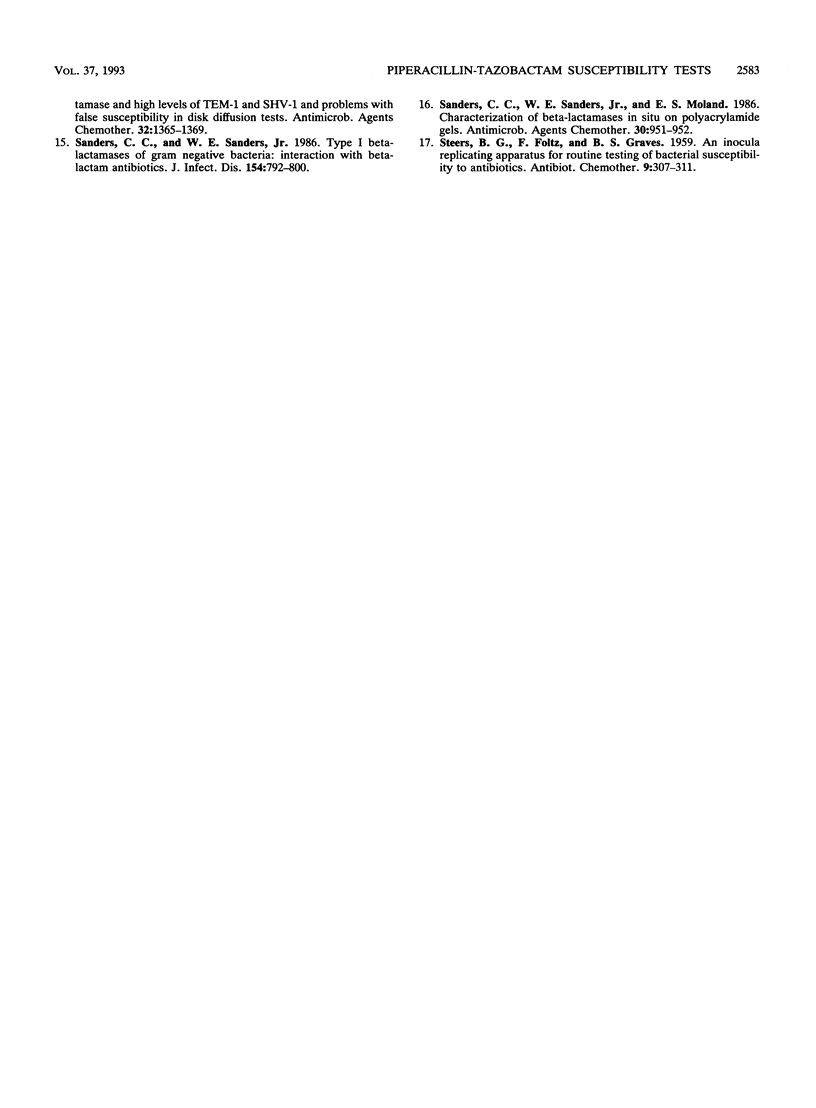Abstract
A predictor panel of clinical isolates that produce a variety of types and amounts of beta-lactamases was used to assess the accuracy of dilution and disk diffusion susceptibility tests for piperacillin-tazobactam. Combinations of piperacillin-tazobactam with a fixed ratio of 8:1 and with tazobactam held constant at 4 micrograms/ml were examined in dilution tests performed in agar. In addition, disks containing 100 and 10 micrograms of piperacillin and tazobactam, respectively, were examined in diffusion tests. Three very major discrepancies between MICs determined with an 8:1 ratio and MICs determined with tazobactam held constant at 4 micrograms/ml were noted. These involved strains that appeared to be susceptible in tests with the 8:1 ratio but resistant when tazobactam was held constant at 4 micrograms/ml. However, the differences were only twofold. Error rate-bounded analysis with the disk containing 100 and 10 micrograms of piperacillin and tazobactam, respectively, revealed low error rates, regardless of whether MICs were determined with an 8:1 ratio or tazobactam held constant at 4 micrograms/ml. Thus, a predictor panel was useful in the identification of accurate susceptibility test for piperacillin-tazobactam.
Full text
PDF





Selected References
These references are in PubMed. This may not be the complete list of references from this article.
- Barry A. L., Jones R. N. In vitro activities of ampicillin-sulbactam and cefoperazone-sulbactam against oxacillin-susceptible and oxacillin-resistant staphylococci. Antimicrob Agents Chemother. 1990 Sep;34(9):1830–1832. doi: 10.1128/aac.34.9.1830. [DOI] [PMC free article] [PubMed] [Google Scholar]
- Barry A. L., Jones R. N. Proposed changes in interpretive criteria and potency of ampicillin and ampicillin-sulbactam disks for susceptibility tests. J Clin Microbiol. 1988 Apr;26(4):750–754. doi: 10.1128/jcm.26.4.750-754.1988. [DOI] [PMC free article] [PubMed] [Google Scholar]
- Barry A. L., Jones R. N., Thornsberry C. Interpretive standards and quality control limits for susceptibility tests with ampicillin-sulbactam combination disks. J Clin Microbiol. 1984 Feb;19(2):134–139. doi: 10.1128/jcm.19.2.134-139.1984. [DOI] [PMC free article] [PubMed] [Google Scholar]
- Bradford P. A., Sanders C. C. Use of a predictor panel for development of a new disk for diffusion tests with cefoperazone-sulbactam. Antimicrob Agents Chemother. 1992 Feb;36(2):394–400. doi: 10.1128/aac.36.2.394. [DOI] [PMC free article] [PubMed] [Google Scholar]
- Bradford P. A., Sanders C. C. Use of a predictor panel to evaluate susceptibility testing methods for ampicillin-sulbactam. Antimicrob Agents Chemother. 1993 Feb;37(2):251–259. doi: 10.1128/aac.37.2.251. [DOI] [PMC free article] [PubMed] [Google Scholar]
- Fuchs P. C., Barry A. L., Jones R. N. In vitro activity and disk susceptibility of Timentin: current status. Am J Med. 1985 Nov 29;79(5B):25–32. doi: 10.1016/0002-9343(85)90125-1. [DOI] [PubMed] [Google Scholar]
- Jones R. N., Barry A. L. Studies to optimize the in vitro testing of piperacillin combined with tazobactam (YTR 830). Diagn Microbiol Infect Dis. 1989 Nov-Dec;12(6):495–510. doi: 10.1016/0732-8893(89)90084-9. [DOI] [PubMed] [Google Scholar]
- Metzler C. M., DeHaan R. M. Susceptibility tests of anaerobic bacteria: statistical and clinical considerations. J Infect Dis. 1974 Dec;130(6):588–594. doi: 10.1093/infdis/130.6.588. [DOI] [PubMed] [Google Scholar]
- Pfaller M. A., Barry A. L., Fuchs P. C., Gerlach E. H., Hardy D. J., McLaughlin J. C. Comparison of fixed concentration and fixed ratio options for testing susceptibility of gram-negative bacilli to piperacillin and piperacillin/tazobactam. Eur J Clin Microbiol Infect Dis. 1992 Aug;11(8):728–732. doi: 10.1007/BF01989979. [DOI] [PubMed] [Google Scholar]
- Sanders C. C., Iaconis J. P., Bodey G. P., Samonis G. Resistance to ticarcillin-potassium clavulanate among clinical isolates of the family Enterobacteriaceae: role of PSE-1 beta-lactamase and high levels of TEM-1 and SHV-1 and problems with false susceptibility in disk diffusion tests. Antimicrob Agents Chemother. 1988 Sep;32(9):1365–1369. doi: 10.1128/aac.32.9.1365. [DOI] [PMC free article] [PubMed] [Google Scholar]
- Sanders C. C., Sanders W. E., Jr, Moland E. S. Characterization of beta-lactamases in situ on polyacrylamide gels. Antimicrob Agents Chemother. 1986 Dec;30(6):951–952. doi: 10.1128/aac.30.6.951. [DOI] [PMC free article] [PubMed] [Google Scholar]
- Sanders C. C., Sanders W. E., Jr Type I beta-lactamases of gram-negative bacteria: interactions with beta-lactam antibiotics. J Infect Dis. 1986 Nov;154(5):792–800. doi: 10.1093/infdis/154.5.792. [DOI] [PubMed] [Google Scholar]


